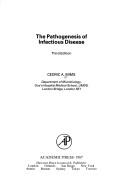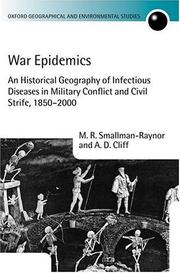| Listing 1 - 10 of 19 | << page >> |
Sort by
|
Digital
Abstract | Keywords | Export | Availability | Bookmark
 Loading...
Loading...Choose an application
- Reference Manager
- EndNote
- RefWorks (Direct export to RefWorks)
Quarantine --- Plague --- Communicable diseases -- Transmission

ISBN: 0124982611 9780124982611 Year: 1987 Publisher: London : Academic Press,
Abstract | Keywords | Export | Availability | Bookmark
 Loading...
Loading...Choose an application
- Reference Manager
- EndNote
- RefWorks (Direct export to RefWorks)
Book
ISBN: 9781107668188 1107668182 9781316179390 9781139002967 Year: 2012 Publisher: Cambridge Cambridge University Press
Abstract | Keywords | Export | Availability | Bookmark
 Loading...
Loading...Choose an application
- Reference Manager
- EndNote
- RefWorks (Direct export to RefWorks)
Despite numerous scientific investigations on vector-borne human infections such as malaria, filariasis, Lyme disease and typhus, these diseases continue to threaten human health. Understanding the role of vectors in disease transmission, and the most appropriate control strategies, is therefore essential. This book provides information on the recognition, biology, ecology and medical importance of the arthropods that affect human health. The fifth edition of this popular textbook is completely updated, and incorporates the latest strategies for controlling insects, ticks and mites. Numerous illustrations, with new colour photographs of some of the most important vectors, aid recognition. A glossary of entomological and epidemiological terms is included, along with a list of commonly used insecticides and their trade names. Clearly presented in a concise style, this text is aimed at students of medical entomology, tropical medicine, parasitology and pest control. It is also essential reading for physicians, health officials and community health workers.
Insects --- Arachnid Vectors. --- Arachnida --- Communicable Diseases --- Insect Vectors. --- Entomology. --- Insects as carriers of disease. --- Insectes (Vecteurs de maladies) --- Entomologie --- pathogenicity. --- transmission. --- Arachnid Vectors --- Insect Vectors --- pathogenicity --- transmission --- Insecta --- Insects - pathogenicity --- Arachnida - pathogenicity --- Communicable Diseases - transmission

ISBN: 0198233647 9780198233640 Year: 2004 Volume: *3 Publisher: Oxford Oxford University Press
Abstract | Keywords | Export | Availability | Bookmark
 Loading...
Loading...Choose an application
- Reference Manager
- EndNote
- RefWorks (Direct export to RefWorks)
War --- Epidemics --- Communicable diseases --- Communicable Diseases --- Disease Outbreaks --- Medical aspects --- History --- Transmission --- epidemiology --- history --- War - Medical aspects - History --- Epidemics - History --- Communicable diseases - Transmission - History --- Communicable Diseases - epidemiology --- Disease Outbreaks - history
Book
ISBN: 9780198565765 Year: 2011 Publisher: Oxford Oxford University Press
Abstract | Keywords | Export | Availability | Bookmark
 Loading...
Loading...Choose an application
- Reference Manager
- EndNote
- RefWorks (Direct export to RefWorks)
* Includes worked examples, together with exercises based on real data and real-life problems* Contains a glossary of key definitions and abbreviations* Accessible to the majority of readers as it does not assume advanced mathematical skills* Accompanied by online files and solutions to exercisesMathematical models are increasingly being used to examine questions in infectious disease control. Applications include predicting the impact of vaccination strategies against common infections and determining optimal control strategies against HIV and pandemic influenza.This book introduces individuals interested in infectious diseases to this exciting and expanding area. The mathematical level of the book is kept as simple as possible, which makes the book accessible to those who have not studied mathematics to university level. Understanding is further enhanced by models that can be accessed online, which will allow readers to explore the impact of different factors and control strategies, and further adapt and develop the models themselves.The book is based on successful courses developed by the authors at the London School of Hygiene and Tropical Medicine. It will be of interest to epidemiologists, public health researchers, policy makers, veterinary scientists, medical statisticians and infectious disease researchers.
Mathematical statistics --- Epidemiology --- WA 110 Prevention and control of communicable diseases. Transmission of infectious diseases --- Disease Transmission, Infectious --- Models, Theoretical --- Handbooks --- HIV Infections --- Influenza, Human --- Communicable diseases --- Mathematical models
Book
ISBN: 0191653446 9780191653445 1306426502 9781306426503 9780199641024 0199641021 0191653454 Year: 2014 Publisher: Oxford
Abstract | Keywords | Export | Availability | Bookmark
 Loading...
Loading...Choose an application
- Reference Manager
- EndNote
- RefWorks (Direct export to RefWorks)
An extraordinary array of infectious agents affects humans; from worms, arthopods, and fungi to bacteria, viruses, and prions. In this compendium of the curious and fascinating organisms that cause disease, including Legionnaire's disease, mumps, CJD, and chlamydia, David I. Grove provides a lively, fact-filled account of the nature of each organism, their life cycle, the ingenious ways in which they infect humans, and the human stories behind their discovery.
Parasitic diseases. --- Prion diseases. --- Pediculosis. --- Tapeworms. --- Cestoda --- Cestodes --- Platyhelminthes --- Head lice infestation --- Lice infestation --- Phtheiriasis --- Phthiriasis --- Ectoparasitic infestations --- Encephalopathies, Spongiform --- Prion infections --- Spongiform encephalopathies --- Transmissible spongiform encephalopathies --- Unconventional slow virus diseases --- Communicable diseases --- Slow virus diseases --- Medical parasitology --- Bacterial Infections --- Mycoses --- Virus Diseases --- Parasitic Diseases --- Communicable Diseases --- Disease Vectors --- Arthropod Vectors --- Vector-pathogen relationships --- Worms as carriers of disease --- Arthropod vectors --- Pathogenic fungi --- Pathogenic bacteria --- history --- transmission --- Transmission --- Bacterial Infections - history --- Mycoses - history --- Virus Diseases - history --- Parasitic Diseases - history --- Communicable Diseases - transmission --- Communicable diseases - Transmission
Book
ISBN: 9782130542940 2130542948 Year: 2004 Publisher: Paris Presses Universitaires de France
Abstract | Keywords | Export | Availability | Bookmark
 Loading...
Loading...Choose an application
- Reference Manager
- EndNote
- RefWorks (Direct export to RefWorks)
Communicable diseases - History --- Communicable diseases - Transmission - History --- Communicable diseases --- Geschiedenis der geneeskunde --- Infectieziekten --- Oorlog --- Wapens --- Contagion and contagious diseases --- Contagious diseases --- Infectious diseases --- Microbial diseases in human beings --- Zymotic diseases --- Diseases --- Infection --- Epidemics --- History --- Transmission --- Histoire de la médecine --- Maladies infectieuses --- Guerre --- Armes
Book
ISBN: 9782757887233 2757887238 Year: 2020 Volume: S226 Publisher: Paris: Seuil,
Abstract | Keywords | Export | Availability | Bookmark
 Loading...
Loading...Choose an application
- Reference Manager
- EndNote
- RefWorks (Direct export to RefWorks)
Quatrième de couverture : "Comment de nouvelles maladies infectieuses apparaissent-elles ? Pourquoi certains antibiotiques cessent-ils d'être efficaces ? Quels impacts peuvent avoir les changements de mode de vie ou les politiques de santé publique sur la virulence des agents pathogènes ? La pandémie du nouveau coronavirus humain, après celles du VIH ou de bactéries multi-résistantes, illustre de manière éclatante l'importance et la rapidité de l'évolution des microbes. A l'approche pasteurienne, qui décortique les mécanismes cellulaires pour apporter des réponses au niveau individuel, il est nécessaire d'associer une approche darwinienne qui étudie la dynamique des populations au sein de leurs environnements : seule une démarche intégrant les deux approches permettra de maîtriser les agents infectieux et de trouver des traitements tant originaux que durables."
Communicable Diseases --- Communicable Diseases, Emerging --- Drug Resistance, Microbial --- Biological Evolution --- Genetics, Microbial --- transmission --- history --- genetics --- Communicable diseases. --- Drug resistance in microorganisms --- Emerging infectious diseases --- Medical policy --- Viruses --- Maladies infectieuses --- Résistance aux antibiotiques --- Médecine darwinienne --- Maladies émergentes --- Politique sanitaire --- Virus --- Evolution --- Évolution. --- Communicable Diseases - transmission --- Communicable Diseases, Emerging - history --- Drug Resistance, Microbial - genetics
Book
ISBN: 354052004X 038752004X 3642753035 3642753019 9780387520049 9783540520047 Year: 1993 Volume: 23 Publisher: Berlin Springer
Abstract | Keywords | Export | Availability | Bookmark
 Loading...
Loading...Choose an application
- Reference Manager
- EndNote
- RefWorks (Direct export to RefWorks)
Biomathematics. Biometry. Biostatistics --- Stochastic processes --- Communicable diseases in the fetus --- Communicable diseases in newborn infants --- Communicable Diseases --- Infant, Newborn, Diseases --- Models, Statistical --- Pregnancy Complications, Infectious --- Mathematical models --- Forecasting --- transmission --- epidemiology --- Issue --- Models, Statistical. --- Forecasting. --- Mathematical models. --- transmission. --- epidemiology. --- Transmission. --- Epidemiology. --- Communicable diseases in the fetus - Mathematical models --- Communicable diseases in the fetus - Forecasting --- Communicable diseases in newborn infants - Mathematical models --- Communicable diseases in newborn infants - Forecasting --- Communicable Diseases - transmission --- Infant, Newborn, Diseases - epidemiology --- Pregnancy Complications, Infectious - epidemiology
Book
ISBN: 0081015399 1908818735 1907568573 1322184186 9781908818737 9781907568572 9780081015391 Year: 2014 Publisher: Cambridge, England : Woodhead Publishing,
Abstract | Keywords | Export | Availability | Bookmark
 Loading...
Loading...Choose an application
- Reference Manager
- EndNote
- RefWorks (Direct export to RefWorks)
The increase of immigrant population in developed countries (mainly in Europe and North America) together with an important increase of international travel worldwide are the two most important causes that have contributed to the introduction and diagnosis of imported/tropical infectious diseases in these countries. These factors have had an important impact in developed countries in both social and economic aspects. Imported Infectious Diseases focuses not only on describing the infections, but also in evaluating the current epidemiology, the economic and social impact and the possibility to
Communicable diseases -- Transmission. --- Emigration and immigration -- Health aspects. --- Immigrants -- Diseases. --- International Cooperation --- Persons --- Infection --- Internationality --- Bacterial Infections and Mycoses --- Named Groups --- Diseases --- Social Sciences --- Anthropology, Education, Sociology and Social Phenomena --- Emigrants and Immigrants --- Developed Countries --- Communicable Diseases --- Public Health --- Health & Biological Sciences --- Transmission of Disease --- Communicable diseases --- Transmission. --- Communicable disease transmission --- Disease transmission --- Germs, Spread of --- Spread of communicable diseases --- Spread of germs --- Transmission of diseases --- Epidemiology --- Transmission
| Listing 1 - 10 of 19 | << page >> |
Sort by
|

 Search
Search Feedback
Feedback About UniCat
About UniCat  Help
Help News
News